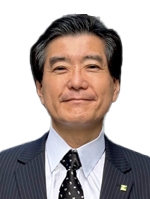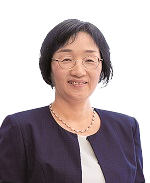School excursions to Hiroshima as a starting point for children to acquire a 'culture of peace'
-From the results of a survey of each school-
Shiro Tani
Vice Chairperson, Hiroshima Peace Culture Foundation

Shiro Tani
Vice Chairperson, Hiroshima Peace Culture Foundation
The number of children visiting Hiroshima on school excursions was approximately 344,000 in FY2023.
Assuming that each child goes on a school excursion to Hiroshima only once, this indicates the significant fact that about onethird of children throughout Japan have visited our city.
The percentages of visits by region were 102% for the Chugoku region, 76% for the Shikoku region, 49% for the Kansai region, and 22% for the Kanto region.
In order to expand such school excursions to Hiroshima, we conducted a survey of 1,121 elementary, junior high and high schools across Japan this March, and received responses from 41%, or 456 schools. I really appreciate their cooperation.
Three important matters that were found in this survey can be mentioned here.
First, we have found that children come to feel war and the atomic bombing as real things through the Hiroshima school excursion.
The synergy of various learning experiences such as tours, lectures and peace gatherings conducted on site in Hiroshima, such as the Atomic Bomb Dome and Peace Memorial Museum, which show how Hiroshima was at that time; the people of Hiroshima, including hibakusha, who speak about peace in the first person; the unique atmosphere of Peace Memorial Park that inspires visitors to pursuit world peace; the foreign tourists who visit the park with great enthusiasm to learn about the A-bombing; and the damage suffered by children of the same generation and the grief of their families, all contribute to the realization of a real and vivid experience of the tragedy and foolishness of war, and the horror of the A-bomb damage. In other words, they will begin to think about it not as something that happened in the past or in other regions, but as something that feels like one's own experience or the experience of a loved one.
Secondly, the process by which children develop a sense of respect for peace, taking this realization as a starting point, has become clear.
War and the atomic bomb are the direct opposite of peace, so understanding them as reality leads to the realization that the peaceful days we used to take for granted should not in fact be taken for granted at all, but were hard earned through the efforts and many sacrifices of our ancestors. This is why peace is not something that can be given to us in silence, but rather, it awakens in us the awareness that we must actively protect it.
This awareness will grow into an awareness of our own commitment to peace.
Specifically, children will understand that all forms of violence must be rejected, and that even if a conflict arises, it must be resolved peacefully through discussion. This will be accompanied by efforts that children can make in their daily lives, such as practically valuing relationships with their friends, obeying rules, and doing the right thing.
Furthermore, as members of society, they will recognize their responsibility to pass on their war and A-bomb experiences to future generations, and to raise their voices with an interest in the abolition of nuclear weapons and lasting peace in the world.
Thirdly, the needs of the schools were clarified.
In terms of developing a more diverse peace education program, schools were highly interested in the following items: 1)the Peace Museums at Honkawa and Fukuromachi Elementary Schools, 2)professional guides such as Hiroshima Peace Volunteers, 3)peace gatherings at the Peace Memorial Hall, 4)the new soccer stadium as a lunch site, and 5)exchange with children in Hiroshima. On the other hand, there were also requests for support for 6)easing the crowding at Hiroshima Peace Memorial Museum, 7)accommodating exhibits and other activities according to children's characteristics, and 8)support for prior learning at each school.
In response to this survey, we would like to provide feedback on the first and second benefits of peace education to schools that currently offer school excursions to Hiroshima so that they may be useful for them, and also to schools outside of western Japan, that don't usually offer school excursions to Hiroshima to deepen their awareness of the need for peace education and the importance of the Hiroshima school excursion.
Through such activities, we will also strive to develop a methodology for peace education in Hiroshima.
Furthermore, based on the third point, regarding the needs of the schools, Hiroshima would like to develop concrete necessary support measures.
 Many elementary, junior high, and high schools have chosen Hiroshima as their school excursion destination to provide children with peace education.
This survey revealed that actually visiting the A-bombed city of Hiroshima and experiencing the reality of the atomic bombing is a highly effective way to develop children's awareness of peace, as it leads them to feel war and the atomic bombing in a realistic way.
We hope that school excursions to Hiroshima will spread throughout Japan, to continue to convey the importance of building a peaceful world that transcends time and countries.
Many elementary, junior high, and high schools have chosen Hiroshima as their school excursion destination to provide children with peace education.
This survey revealed that actually visiting the A-bombed city of Hiroshima and experiencing the reality of the atomic bombing is a highly effective way to develop children's awareness of peace, as it leads them to feel war and the atomic bombing in a realistic way.
We hope that school excursions to Hiroshima will spread throughout Japan, to continue to convey the importance of building a peaceful world that transcends time and countries.
In order to expand such school excursions to Hiroshima, we conducted a survey of 1,121 elementary, junior high and high schools across Japan this March, and received responses from 41%, or 456 schools. I really appreciate their cooperation.
First, we have found that children come to feel war and the atomic bombing as real things through the Hiroshima school excursion.
The synergy of various learning experiences such as tours, lectures and peace gatherings conducted on site in Hiroshima, such as the Atomic Bomb Dome and Peace Memorial Museum, which show how Hiroshima was at that time; the people of Hiroshima, including hibakusha, who speak about peace in the first person; the unique atmosphere of Peace Memorial Park that inspires visitors to pursuit world peace; the foreign tourists who visit the park with great enthusiasm to learn about the A-bombing; and the damage suffered by children of the same generation and the grief of their families, all contribute to the realization of a real and vivid experience of the tragedy and foolishness of war, and the horror of the A-bomb damage. In other words, they will begin to think about it not as something that happened in the past or in other regions, but as something that feels like one's own experience or the experience of a loved one.
Secondly, the process by which children develop a sense of respect for peace, taking this realization as a starting point, has become clear.
War and the atomic bomb are the direct opposite of peace, so understanding them as reality leads to the realization that the peaceful days we used to take for granted should not in fact be taken for granted at all, but were hard earned through the efforts and many sacrifices of our ancestors. This is why peace is not something that can be given to us in silence, but rather, it awakens in us the awareness that we must actively protect it.
This awareness will grow into an awareness of our own commitment to peace.
Specifically, children will understand that all forms of violence must be rejected, and that even if a conflict arises, it must be resolved peacefully through discussion. This will be accompanied by efforts that children can make in their daily lives, such as practically valuing relationships with their friends, obeying rules, and doing the right thing.
Furthermore, as members of society, they will recognize their responsibility to pass on their war and A-bomb experiences to future generations, and to raise their voices with an interest in the abolition of nuclear weapons and lasting peace in the world.
Thirdly, the needs of the schools were clarified.
In terms of developing a more diverse peace education program, schools were highly interested in the following items: 1)the Peace Museums at Honkawa and Fukuromachi Elementary Schools, 2)professional guides such as Hiroshima Peace Volunteers, 3)peace gatherings at the Peace Memorial Hall, 4)the new soccer stadium as a lunch site, and 5)exchange with children in Hiroshima. On the other hand, there were also requests for support for 6)easing the crowding at Hiroshima Peace Memorial Museum, 7)accommodating exhibits and other activities according to children's characteristics, and 8)support for prior learning at each school.
Furthermore, based on the third point, regarding the needs of the schools, Hiroshima would like to develop concrete necessary support measures.
Comment by Yumiko Suzuki, Executive Vice-President, Hiroshima University

Hiroshima Peace Culture Foundation
1-2 Nakajima-cho, Naka-ku, Hiroshima 730-0811 JAPAN
Phone 082-241-5246
Copyright © Since April 1, 2004, Hiroshima Peace Culture Foundation. All rights reserved.